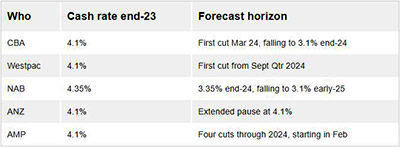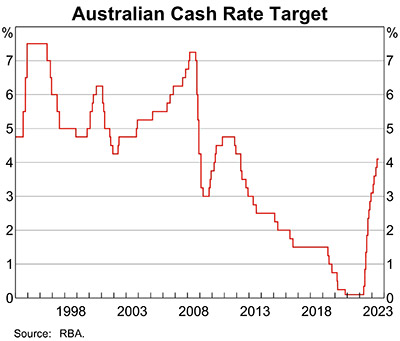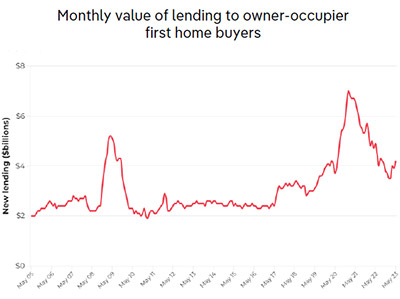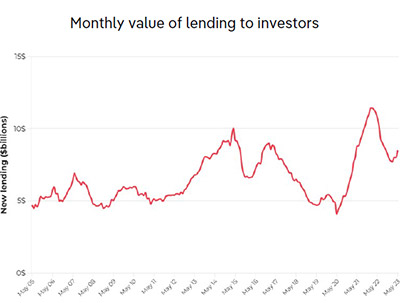Have interest rates finally peaked?
As economic factors play tug-of-war with interest rates, speculation is rife that the Reserve Bank's next move might be downwards but others are less convinced.
Consecutive months of the official cash rate being left on hold have raised hopes among many borrowers that the next move by the Reserve Bank may be to cut rather than hike.
Just over a month ago financial institutions were tipping rates would not peak until there had been at least one more rate hike but the RBA’s newfound cautious tone has them rethinking.
Among the four biggest banks and AMP only one, NAB is tipping another 0.25 per cent interest rate hike before the year is out.

CBA, Westpac, ANZ and AMP are all predicting an extended pause as the previous rate hikes take effect in lowering inflation that sits at 6 per cent, well above the RBA’s preferred band of 2 to 3 per cent.
But the biggest shift in sentiment is that those same four institutions are predicting rate cuts throughout 2024, from as early as February (AMP) to as low as 3.1 per cent (CBA).
It is in some ways a curious shift in sentiment given it was only this week that RBA Governor Philip Lowe said further tightening may be required in the face of wage growth pressure and stagnant productivity.
Tuesday’s pause will give the RBA more time to assess the impact of previous rate hikes, having increased the official cash rate by 4 per cent since the first hike in May 2022.

Retail turnover figures released by the Australian Bureau of Statistics (ABS) on Thursday (3 August) showed a decline month-on-month that should encourage the RBA to wait and see before moving rates either direction.
Mr Lowe, however, made it a strong statement that indicated a reprieve from further rate rises may be short lived.
He pointed to “significant uncertainties” that may necessitate further rate hikes in the months ahead.
Driving that upwards pressure are the soaring price of services, including rental and energy costs, the delayed impact of monetary tightening, and the fragility of household consumption.
Bilgehan Karabay, Associate Professor, Economics at RMIT, was less swayed by the banks’ optimistic views on a rate cut any time soon.
“While the inflation rate is still far from the RBA’s target of 2 per cent, the potential negative effects of higher interest rates on economic growth seem to be concerning the board members.
“At the same time, they are also careful about the labour market effects of tighter credit conditions.
“Given the uncertainty regarding the time frame in which interest rates operate (there is a lag of 12 to 18 months), they decided to wait for more data to justify further rate hikes.
“However, this does not necessarily imply that we are at the end of the interest rate hike cycle.
“Recently, oil prices have been increasing and if this continues, we will likely see a spike in inflation again that will require the RBA to raise rates again.
“When we look at the composition of inflation, it seems like goods inflation is more responsive to interest rate increases than services inflation.
“This is valid not only for Australia, but also other economies. Given the tight rental market, rental prices continue to put pressure on inflation.
“In addition, house prices seem to be plateauing, which is due to two effects that offset each other – on the one hand, high interest rates decrease loan applications and curb demand, on the other, high construction costs limit housing supply.”
Property prices rising, borrowers refinancing
Higher interest rates are making it more expensive to service mortgage debt, and lenders are offering less finance to would-be buyers.
In response, borrowers in search of rate relief continue to switch lenders in droves, with $20.18 billion of loans refinanced in June – the third highest on record.
ABS lending indicator data released today for June shows this was a slight drop of $650 million from the month before, but an increase of $2.26 billion from the same time last year.
Owner-occupier loans fell 2.8 per cent this month after a noteworthy rise the month before. However, investor lending picked up some of the slack, increasing by 2.6 per cent in June.
Year-on-year, both owner-occupier and investor lending are down by 20 per cent and 15 per cent respectively as the 12 RBA hikes take their toll.

Source: PropTrack

Despite the trying financial situation confronting many households, the rebound in property sales this year and a low volume of stock for sale continues to support prices.
The rapid rise in national population is also fuelling housing demand, which in turn supports prices.
While these conditions persist, we expect moderate price growth to continue. The potential headwinds for property prices include interest rate increases, not matter how unexpected they may prove to be.
Additionally, mortgage arrears increasing from historic lows as many borrowers reset from extremely low fixed mortgage rates, and the potential for more stock to hit the market due to these factors and rising prices, may influence the market.
Turning the collective gaze overseas does little to ease the nerves in regards to another rate rise too. Both the US and UK continue to lift rates well above Australia’s 4.1 per cent.
The US Federal Reserve approved a much-anticipated interest rate hike that takes benchmark borrowing costs to their highest level in more than 22 years, to a target range of 5.25%-5.5%.
The Bank of England this week raised interest rates by 25 basis points to 5.25 percent, the 14th consecutive rise since December 2021.




















